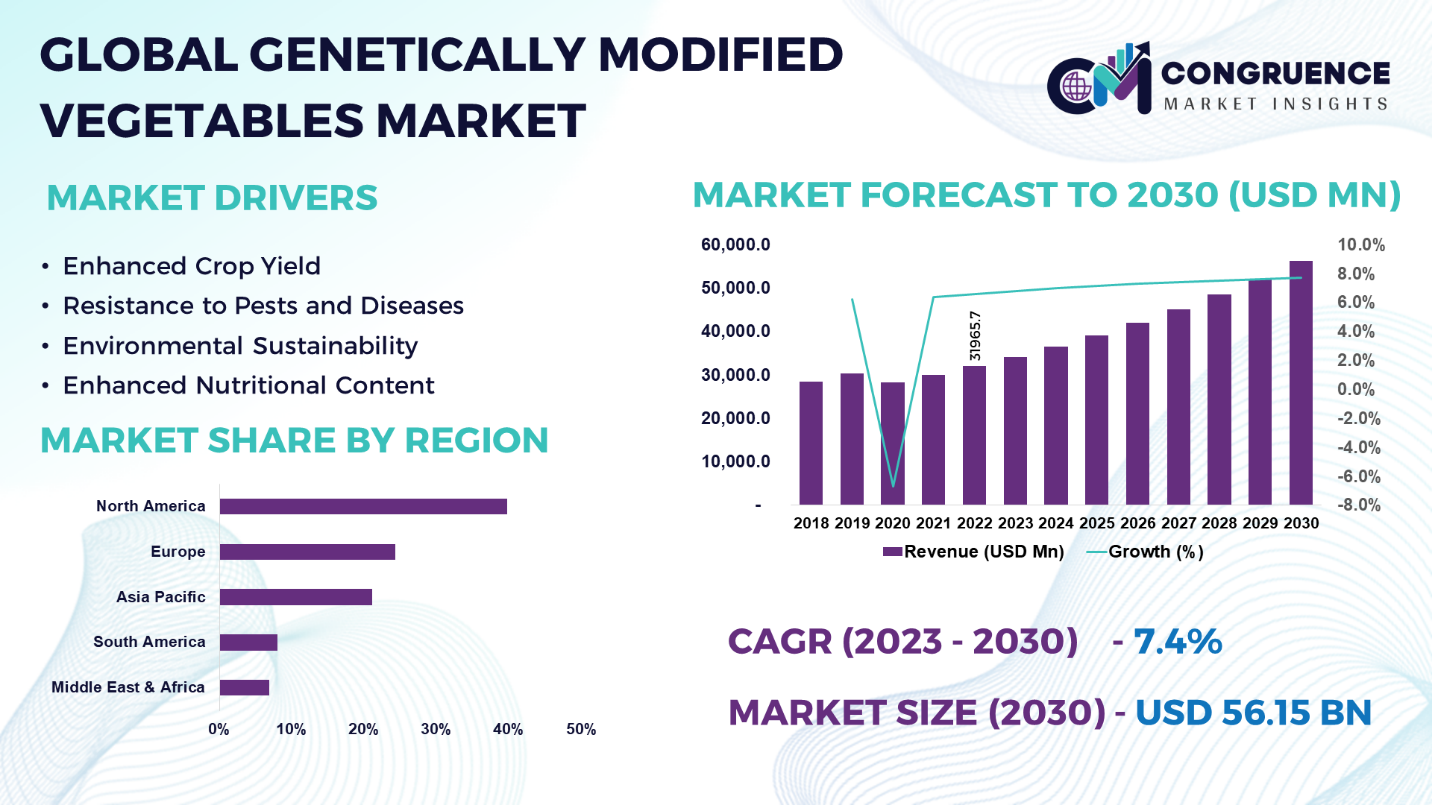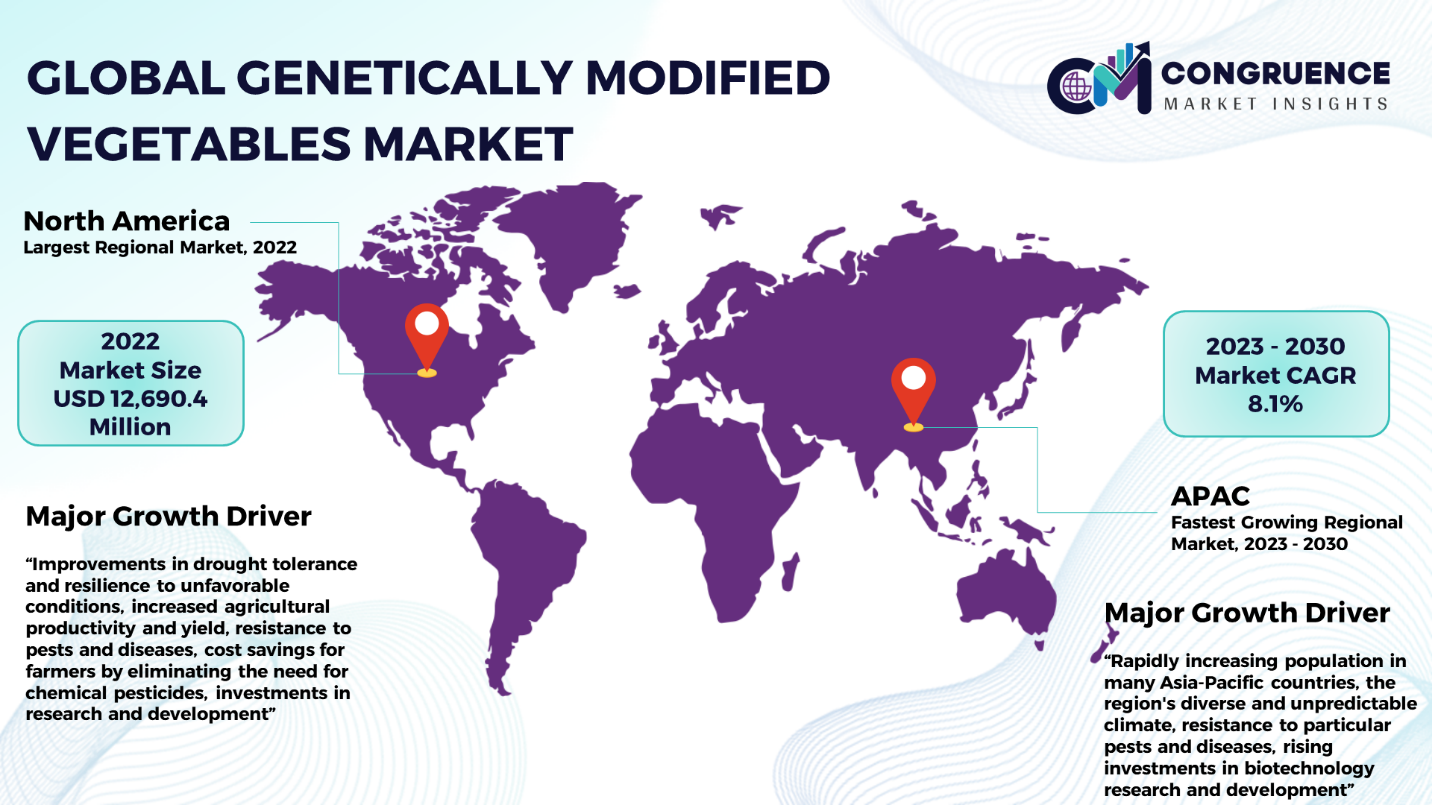Reports
The Global Genetically Modified Vegetables Market was valued at USD 31,965.7 Million in 2022 and is anticipated to reach a value of USD 56,151.7 Million by 2030 expanding at a CAGR of 7.4% between 2023 and 2030.
Vegetables labeled as Genetically Modified (GM) are those that have had their genetic makeup altered using biotechnology methods. In order to give the plant particular desired qualities, scientists modify the genetic material of the plant, usually by adding genes from other organisms. Genetically modified crops (GM crops) are created when a crop's DNA or genetic material is changed to achieve an outcome that is not normally seen in nature. In contrast to their typical and recognizable yellow color, genetically modified fruits and vegetables are renowned for their vivid and unusual hues. Examples of these include rainbow-colored corn and pineapples with pink flesh. The creative ways in which produce can be transformed are fascinating, yet the debate around genetically modified food is intense. Enhancing specific traits, including resistance to pests or diseases, tolerance to environmental conditions, increased nutritional value, or longer shelf life, is the main objective of genetically engineering vegetables. A variety of techniques can be used to modify an organism's genetic makeup, such as introducing genes from unrelated organisms, microbes, or other plants.

Genetically Modified Vegetables Market Major Driving Forces
Enhanced Crop Yield: Genetically modified vegetables are frequently designed to withstand pests, illnesses, and unfavorable environmental conditions, which increases crop yields. A major motivator for farmers looking to maximize their agricultural output is this enhanced productivity.
Resistance to Pests and Diseases: By conferring resistance to particular pests and diseases, genetic alterations can lessen the demand for chemical pesticides. Farmers gain from potential improvements in crop quality, fewer input costs, and a smaller environmental effect.
Improvement in Biotechnology: Over the past ten years, biotechnologies have developed quickly, and now they provide novel instruments to aid in crop plant development and breeding initiatives. They include a variety of methods such as genetic modification (GM), marker assisted selection, and tissue culture, and they are being utilized more and more to support conventional breeding initiatives.
Enhanced Nutritional Content: Vegetables' nutritional profiles can be improved by genetic engineering. Scientists can alter crops, for instance, to increase their concentrations of vital vitamins and minerals, so correcting nutritional shortages and offering better dietary options.
Genetically Modified Vegetables Market Key Opportunities
Global Food Security: By boosting crop yields and tolerance to environmental stressors, genetically modified vegetables (GM) have the potential to significantly contribute to addressing concerns related to global food security. There will probably be a greater need for high-yielding, sustainable crops as the world's population grows.
Nutritional Enhancement: GM vegetables have the potential to be developed with improved nutritional profiles, addressing particular nutrient deficits in certain geographical areas. This can improve public health by offering a wider variety of nutrient-dense food options.
Precision Agriculture: Combined with precision agricultural methods, developments in genetic modification technology present prospects for resource optimization. This entails customized adjustments for certain soil kinds, weather patterns, and agricultural methods, resulting in more productive and sustainable agriculture.
Genetically Modified Vegetables Market Key Trends
· The trend towards sustainable agriculture is being driven by a growing consciousness of the influence on the environment.
· Creating genetically modified vegetables (GM) with improved nutritional profiles to target particular health issues is becoming more and more popular.
· A developing trend is the combination of precision agriculture technologies and genetic manipulation.
· Genetically modified vegetables are being investigated for their potential to produce biopharmaceuticals, providing a scalable and affordable production platform.
· One noteworthy achievement is the creation of genetically modified crops that are more resilient to environmental challenges such as drought.
· A growing trend is customizing genetically modified crops to fit regional preferences for taste, appearance, and cultural factors.
· Market dynamics are impacted by the ongoing changes in regulatory frameworks and public scrutiny of genetically modified crops.
Region-wise Market Insights
North America accounted for the largest market share at 39.7% in 2022 whereas, Asia Pacific is expected to register the fastest growth, expanding at a CAGR of 8.1% between 2023 and 2030.

With a market share of 39.7% and a value of USD 12,690.4 million, North America leads the world's genetically modified vegetable industry. Improvements in drought tolerance and resilience to unfavorable conditions, increased agricultural productivity and yield, resistance to pests and diseases, cost savings for farmers by eliminating the need for chemical pesticides, investments in research and development, sustainable agricultural practices, and many other factors are what propel the market in this region. The Asia-Pacific area has shown the fastest development rate in the global market for genetically modified vegetables, with a compound annual growth rate of 8.1%. The region's primary contributors include the rapidly increasing population in many Asia-Pacific countries, the region's diverse and unpredictable climate, which poses challenges to traditional agriculture, resistance to particular pests and diseases, rising investments in biotechnology research and development, genetically modified vegetables (GM) with higher vitamin and mineral content, improved water-use efficiency and tolerance to water stress, and affordable ways to increase productivity, cut losses, and improve overall agricultural sustainability.
Market Competition Landscape
There is fierce competition among many businesses in the global market for genetically engineered veggies. Important participants in the market for genetically engineered vegetables employ tactics meant to give them a competitive advantage. In order to adapt to changing consumer tastes, these methods include product innovation, design distinction, and the use of eco-friendly and sustainable materials. Established companies rely on their quality and dependability reputation to hold onto market share, while more recent competitors concentrate on disruptive technologies and USPs.
The rivalry in the industry has increased due to e-commerce and online shopping, which has given both existing and new brands a platform to reach a larger customer base. The different needs of consumers in different locations also drive market competition. Prominent players in the market include:
· Monsanto (now part of Bayer)
· Syngenta (now owned by ChemChina)
· Corteva Agriscience (formerly DowDuPont)
· BASF
· Bayer Crop Science
· Biocentury Transgene Co., Ltd.
· Mahyco (Maharashtra Hybrid Seeds Company)
· Sakata Seed Corporation
· Nuziveedu Seeds
· Zhejiang University's Qian Xuesen Laboratory of Space Technology
· Calyxt, Inc.
· Arcadia Biosciences
· KWS SAAT SE & Co. KGaA
· Corteva Agriscience (DuPont Pioneer)
· Precigen (formerly Intrexon Corporation)
|
Report Attribute/Metric |
Details |
|
Market Revenue in 2022 |
USD 31,965.7 Million |
|
Market Revenue in 2030 |
USD 56,151.7 Million |
|
CAGR (2023 – 2030) |
7.4% |
|
Base Year |
2022 |
|
Forecast Period |
2023 – 2030 |
|
Historical Data |
2018 to 2022 |
|
Forecast Unit |
Value (US$ Mn) |
|
Key Report Deliverable |
Revenue Forecast, Growth Trends, Market Dynamics, Segmental Overview, Regional and Country-wise Analysis, Competition Landscape |
|
Segments Covered |
· By Modification Type (Transgenic or Gene-Edited) · By Introduced Traits (Pest/Disease Resistance, Herbicide Tolerance, Nutritional Enhancement, Stress Tolerance) · By End-Use Applications (Commercial Farming, Smallholder Farming, Biopharmaceutical Production, Food Processing, Livestock Feed) · By Consumer Preferences (Non-Browning, Organic/Non-GMO Segments) · By Crop Types (GM Corn, Soybeans, Cotton, Tomatoes, Potatoes, and Other Vegetables) |
|
Geographies Covered |
North America: U.S., Canada and Mexico Europe: Germany, France, U.K., Italy, Spain, and Rest of Europe Asia Pacific: China, India, Japan, South Korea, Southeast Asia, and Rest of Asia Pacific South America: Brazil, Argentina, and Rest of Latin America Middle East & Africa: GCC Countries, South Africa, and Rest of Middle East & Africa |
|
Key Players Analyzed |
Bayer (formerly Monsanto), ChemChina (owns Syngenta), Corteva Agriscience (formerly DowDuPont), BASF, Bayer Crop Science, Biocentury Transgene, Mahyco, Sakata Seed, Nuziveedu Seeds, Zhejiang University's Qian Xuesen Laboratory, Calyxt, Inc., Arcadia Biosciences, KWS SAAT SE & Co. KGaA, Corteva Agriscience (DuPont Pioneer), Precigen (formerly Intrexon Corporation). |
|
Customization & Pricing |
Available on Request (10% Customization is Free) |
